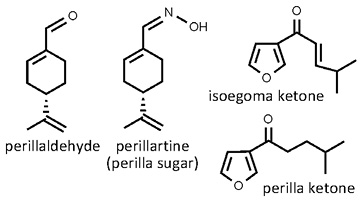 Perilla frutescens
Perilla frutescens
beefsteak plant • shiso • purple mint
Back to “Salad herbs and herb mixtures: beefsteak plant (Perilla frutescens); shiso (Perilla frutescens)”
Back to “Culinary herbs: beefsteak plant (Perilla frutescens); perilla (Perilla frutescens); shiso (Perilla frutescens)”
Perilla frutescens (L.) Britton (= Perilla arguta Benth.) (Lamiaceae); shiso, perilla (Afrikaans); zhou bai su, ri ben bai su (Chinese); pérille verte cultivée, pérille rouge cultivée (French); Perilla, Chinesische Melisse (German); daun shiso (Indonesian); shiso (Japanese); kkaennip, deulkkae, nag-mon, nga-khi-mon (Thai)
DESCRIPTION Shiso leaves are green or purple and typically ruffled, with prominent marginal teeth. They have a distinctive odour reminiscent of mint and cinnamon.
THE PLANT An annual herb (up to 1 m or 3 ft 4 in.) with square stems and minute pink flowers borne in terminal spikes. Two basic types are distinguished: var. frutescens is used in Korea for seed oil production, while var. crispa is used in Japan as a popular garnish and culinary herb. The latter can have green or purple leaves, depending on the cultivar. The green form is known as ao-shiso or aojiso in Japan and the purple form as aka-shiso or akajiso.1
ORIGIN Himalayas to East Asia.1,2 It is a traditional Chinese vegetable that has become an important culinary herb in Japan and important oilseed crop (yegoma) in Korea.1,2 Many cultivars have been developed as ornamental plants (purple forms are especially popular) and for the production of essential oil and seed oil (a drying oil with culinary and industrial uses). The plant has become naturalized in the Ukraine2 and in the eastern parts of the United States.1
CULTIVATION Perilla is easily propagated from seeds and does best in a warm position with well-drained, slightly acid soil.
HARVESTING The leaves are picked as required and are available as fresh herbs in Korean and Japanese markets. The seeds are mechanically harvested for the production of seed oil.
CULINARY USES Fresh shiso leaves are important as a garnish, food colourant, culinary herb and vegetable in Japanese and Korean cooking. The main use in Japan is as a garnish for sashimi or tempura (the leaves may also be battered and deep-fried in the same way as the other components of the dish). The purple form is commonly used to add flavour and colour to the traditional pickled and dried sour plums, known as umeboshi (Prunus mume). The leaves are an ingredient of beni shoga (pickled ginger eaten with sushi).
FLAVOUR COMPOUNDS The aroma of shiso is due to the presence of perillaldehyde, the main compound in the essential oil. It co-occurs with smaller amounts of isoegoma ketone. Perillaldehyde is not present in Korean perilla, which has the potentially poisonous perilla ketone as the main aroma-active compound. The artificially produced oxime of perillaldehyde, known as perillartine or perilla sugar, is 2 000 times sweeter than sucrose. It is used to a limited extent as a sweetener in Japan. The main anthocyanin pigment in purple perilla is a malonyl ester of shisonin.

NOTES The seed oil (important in Korean cooking) is rich in linolenic acid.
1. Brenner, D.M. 1993. Perilla: botany, uses and genetic resources. In: Janick, J., Simon, J.E. (Eds), New crops. Wiley, New York.
2. Mabberley, D.J. 2008. Mabberley’s plant-book (3rd ed.). Cambridge University Press, Cambridge.
3. Başer, K.H.C., Demirci, B., Dönmez, A.A. 2003. Composition of the essential oil of Perilla frutescens (L.) Britton from Turkey. Flavour and Fragrance Journal 18: 122–123.
4. Verma, R.S., Padalia, R.C., Chauhan, A. 2013. Volatile oil composition of Indian Perilla [Perilla frutescens (L.) Britton] collected at different phenophases. Journal of Essential Oil Research 25: 92−96.